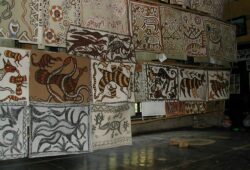Exploring the Enigma: Paul Gauguin’s Masterpiece, ‘Where Do We Come From? What Are We? Where Are We Going?
 Posted On
Posted On
Paul Gauguin, a maverick of the art world in the late 19th century, left an indelible mark on the art scene with his innovative and unconventional approach to painting. Among his most enigmatic and thought-provoking works is the epic masterpiece, ‘Where Do We Come From? What Are We? Where Are We Going?’ This canvas, measuring a colossal 139.1 x 374.6 cm, serves as a visual narrative of human existence and continues to captivate art enthusiasts and scholars alike.
Created between 1897 and 1898 during Gauguin’s self-imposed exile in Tahiti, this painting is an amalgamation of the artist’s personal experiences and his profound philosophical inquiries. The title itself poses existential questions that have intrigued humanity for centuries. Gauguin’s journey to the South Pacific was a quest for a more authentic and primal existence, which is vividly reflected in the painting.
The composition of ‘Where Do We Come From? What Are We? Where Are We Going?’ is strikingly unique. The canvas is divided into three horizontal segments, each representing a different phase of human life. The lower segment portrays infancy and childhood, with a baby and several young children. The middle section portrays adulthood, with figures engaged in various activities, and the upper portion symbolizes old age and the contemplation of life’s meaning.
Gauguin’s use of color in this painting is nothing short of revolutionary. He embraced a bold and vibrant palette, inspired by the lush tropical landscapes of Tahiti. The juxtaposition of vibrant reds, blues, and yellows against the serene backdrop of Tahitian greenery creates a sense of vibrancy and vitality. These colors not only convey the physical beauty of the South Pacific but also represent the emotional and spiritual richness of life itself.
The figures in the painting are equally captivating. Gauguin’s fascination with Tahitian culture is evident in the indigenous people he incorporated into the composition. The women, in particular, exude a sense of sensuality and mystique, adorned with traditional Tahitian garments and ornaments. Their enigmatic expressions invite viewers to ponder the deeper complexities of human existence.
One of the most intriguing elements of ‘Where Do We Come From? What Are We? Where Are We Going?’ is the inclusion of symbolic elements. Gauguin incorporated various symbols and artifacts from Tahitian culture, such as the idol in the background and the fruit-bearing tree. These symbols serve as a visual commentary on the cyclical nature of life, spirituality, and the search for meaning.
The painting’s intricate symbolism is further underscored by Gauguin’s choice of text. He inscribed several questions and statements in the Tahitian language throughout the canvas. These cryptic messages add an additional layer of intrigue, inviting viewers to delve deeper into the mysteries of the painting.
‘Where Do We Come From? What Are We? Where Are We Going?’ is a masterpiece that transcends mere aesthetics. It is a profound meditation on the human condition, the search for purpose, and the inevitable cycle of life and death. Gauguin’s decision to create this monumental work in Tahiti, far from the European art scene, allowed him to tap into the primal and the spiritual, resulting in a painting that continues to inspire and challenge audiences worldwide.
In conclusion, Paul Gauguin’s ‘Where Do We Come From? What Are We? Where Are We Going?’ is a masterpiece that defies easy categorization. It is a visual poem, a philosophical inquiry, and a testament to Gauguin’s unrelenting quest for authenticity. With its vibrant colors, captivating figures, and intricate symbolism, this painting continues to resonate with viewers, inviting them to contemplate life’s deepest questions while marveling at the artistic genius of Paul Gauguin.



